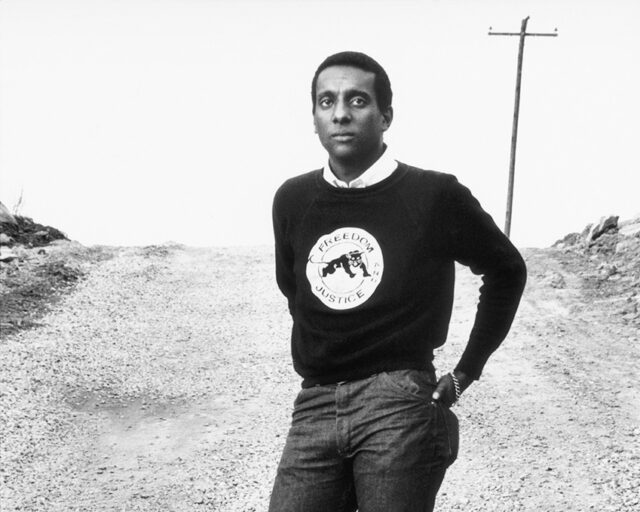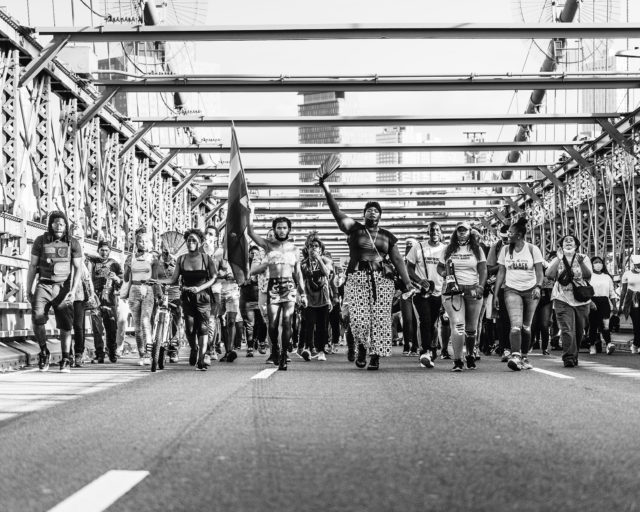Vanguard of the Revolution
In the era of Black Lives Matter, what is the legacy of the Black Panther Party? Stephen Shames revisits his chronicle of American activism.

Stephen Shames, Kathleen Cleaver, Communications Secretary and the first female member of the Party’s decision-making Central Committee, talks with Black Panthers from Los Angeles, in DeFremery Park, West Oakland, California, July 28, 1968
Courtesy Steven Kasher Gallery, New York
Fifty years ago, on October 15, 1966, Huey Newton and Bobby Seale founded the Black Panther Party for Self Defense in Oakland, California. Fifty years ago, it seemed, the world was poised for revolution. And for Newton, the revolution would belong to the people. “The Black Panther Party is simply the vanguard of the revolution,” he declared. It was a statement that perfectly encapsulated the Party’s unprecedented influence in the social, cultural, and political psyche of the United States.
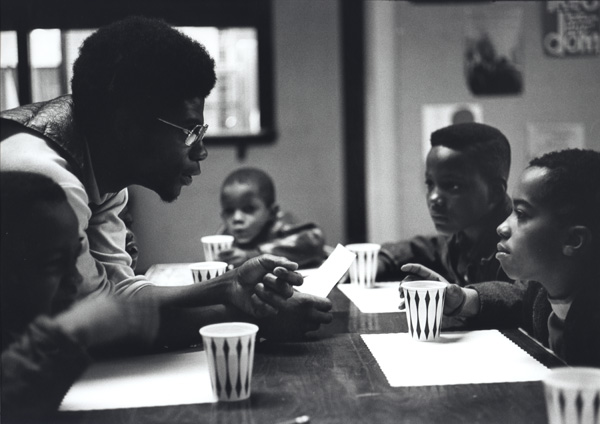
Stephen Shames, Free Breakfast Program, Panther Jerry Dunigan, known as “Odinka,” talks to kids while they eat breakfast on Chicago’s South Side, Chicago, Illinois, 1970
Courtesy Steven Kasher Gallery, New York
Hindsight affords a particular kind of clarity. Years after its first utterance, Newton’s claim remains the most definitive statement regarding the ethos that guided the Panthers. Established on the heels of the civil rights movement, the Panthers were a political party committed to dismantling antiblack structures and policies that had afflicted black people for centuries. The Party espoused a Marxist political stance, manifest in programs such as the Free Breakfast for Children Program and the People’s Free Medical Clinics. Yet, the further we travel away from the Panther era, the greater our chance to distort that reality. The Party was not immune to the surveillance of the federal government; former FBI Director J. Edgar Hoover made it his mission to cripple the Party through his COINTELPRO program. The legacy of Hoover’s actions—infiltration, assassinations, criminalist discourse about the Panthers—still lingers. Should you ask any two people to share their thoughts on the Panthers, you’re likely to receive divided answers about strategy, effectiveness, and importance. They were radicals. They were freedom fighters. They were dangerous. They were gun-toting fanatics.

Stephen Shames, Memorial mural for Jonathan Jackson, who was killed on August 7, 1970, during an attempt to kidnap California Superior Court judge Harold Haley and three others to exchange for the freedom of his brother, George Jackson, Roxbury section of Boston, Massachusetts, 1970
Courtesy Steven Kasher Gallery, New York
At a time when racial tension again hovers over our national consciousness, Power to the People: The World of the Black Panthers, currently on view at Steven Kasher Gallery, reconsiders this revolutionary movement. In the exhibition, Stephen Shames’s photographs are mounted alongside ninety-eight covers of Emory Douglas’s The Black Panther, the newspaper vital to the Party’s communications and outreach. The collaboration between Shames and Seale, together with Douglas’s graphics, forms an illuminating self-portrait of a group of young women and men who sought to create a new, better world for themselves.

Stephen Shames, Black Panther member sells “The Black Panther,” the Party’s newspaper, in the Roxbury section of Boston, Massachusetts, 1970
Courtesy Steven Kasher Gallery, New York
Shames’s photographs—vintage and contemporary gelatin-silver prints—are displayed thematically and loosely follow the timeline of the Panthers’ rise and most active periods of operation. Some of the first images on view depict aspects of Newton’s private life, a welcome departure from his highly visible public persona. In one image from 1970, Newton, the former Minister of Defense for the Party, stands in his living room shortly after his release from prison. Another striking photograph from the same day shows Newton and Central Committee Member Elaine Brown sharing a victorious embrace. In a series of four images, Newton and Seale pose for the photographer, unable to hold their laughter as they prepare for a portrait. They are sensitive, precious photographs of two friends, two young, black men who were confronting the perils of a racist, capitalist empire.

Stephen Shames, Black Panther co-founders Bobby Seale & Huey Newton pose in Huey’s penthouse apartment, Oakland, California, 1971
Courtesy Steven Kasher Gallery, New York
Shames accesses the intimacies of the Party’s interior world, and his photographs evoke a tenderness that is hard to shake. This sense of empathy comes across even in scenes of funeral processions, a testament to Shames’s commitment as a documentarian. We also encounter former Party member Ericka Huggins in the midst of a deep laugh while attending the Party’s Community Survival Conference in Oakland; Party members Ila Mason and Jamal Joseph leading a political education class in Harlem; and a Panther child smiling at the camera in the classroom of the Panthers’ Oakland school. “One thing people don’t understand about the Black Panther Party is that the median age of a Party member in 1969 was nineteen years old,” Huggins notes. The youthfulness of the Panthers was an asset, a potency that enhanced the reach of their radical actions.
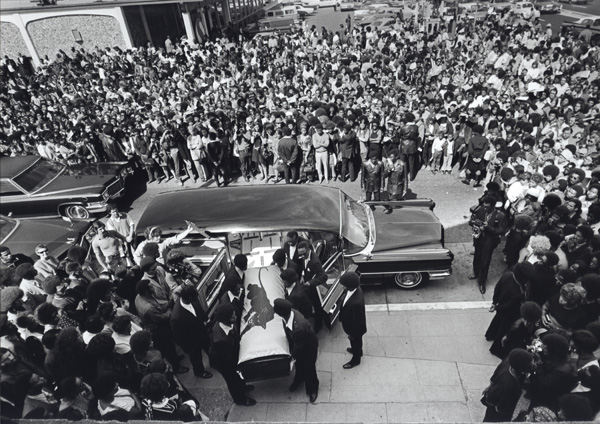
Stephen Shames, Black Panthers carry George Jackson’s coffin into St. Augustine’s Episcopal Church for his funeral service as a huge crowd watches, Oakland, California, August 28, 1971
Courtesy Steven Kasher Gallery, New York
Shames and Seale’s accompanying book, Power to the People: The World of the Black Panthers (2016), chronicles the Party’s founding up until Bobby Seale’s Oakland mayoral campaign in 1973, and privileges the personal accounts of Gloria Abernathy, Kathleen Cleaver, Barbara Cox, Elbert “Big Man” Howard, Ericka Huggins, and Khalid Raheem, among others. The book also incorporates excerpts from Newton’s interviews and speeches into a roundtable of recollections from still-living Party members.

Stephen Shames, Angela Davis, who was a Black Panther for six months, speaks at a Free Huey rally in Defremery Park, Oakland, California, November 12, 1969
Courtesy Steven Kasher Gallery, New York
The exhibition, however, resists sustained analysis in favor of the images. Instead of consistent labels denoting the names, locations, and dates of Shames’s subjects, the decision to display only selected interview excerpts on the gallery walls, drawn from the book, curtails an objective interpretation. (Basic information for each photograph can be found in a gallery guide.) Without the kind of authoritative context a museum or historical institution might provide, this presentation fails to engage with internal rifts and conflicts, a much-needed perspective on gender politics, or the Party’s eventual demise. Perhaps this missed opportunity is a consequence of hindsight. We only immortalize what we think is necessary to immortalize.
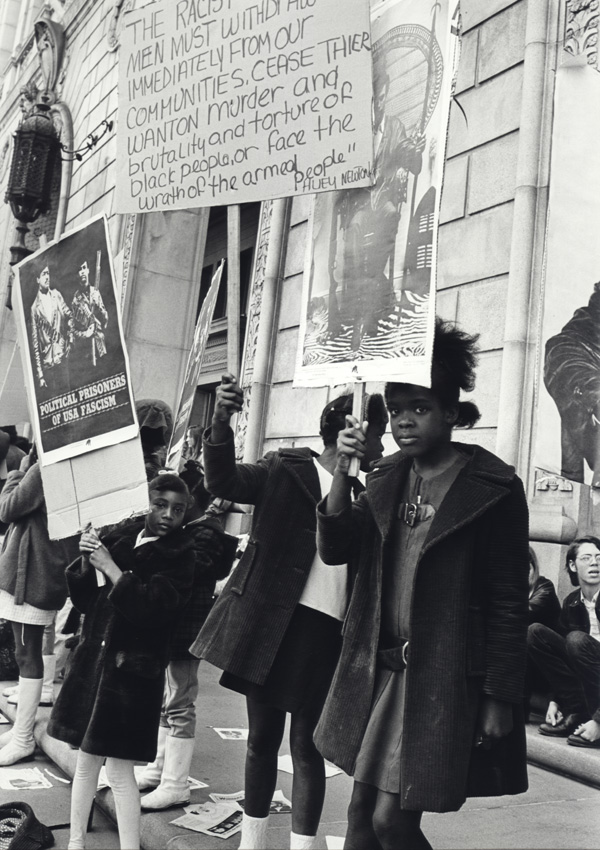
Stephen Shames, Children at a Free Huey, Free Bobby rally in front of the Federal Building, San Francisco, California, February, 1970
Courtesy Steven Kasher Gallery, New York
Still, the Panthers’ legacy looms large. As we witness the rise of a new group of young, black, activists in the U.S., and as we continue pursuing a vision of liberty that includes all Americans, the story of the Black Panther Party remains a vital point of reference. We see traces of their actions in the interventions of the Black Lives Matter movement, asserting the humanity of black people in the face of incessant state-sanctioned violence, or in the vision of The Black School, a new experimental art school which foregrounds radical black politics and socially engaged art as methodology for educating students. But, the world the Panthers imagined is yet to come. If the lessons of the Party’s successes and failures can offer us any insight, it would be their insistent demand to organize, resist, and ultimately, to act.
Power to the People: The Black Panthers in Photographs by Stephen Shames and Graphics by Emory Douglas is on view at Steven Kasher Gallery, New York, through October 29, 2016.










